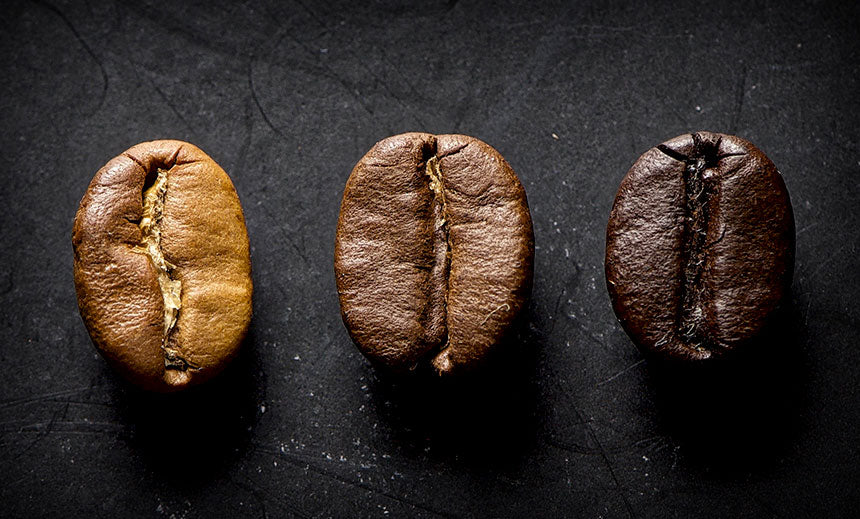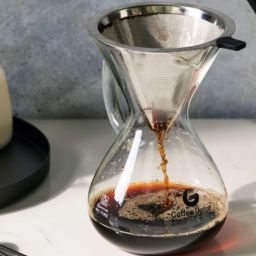
Coffee roasting is an art that transforms the chemical and physical properties of green coffee beans into roasted coffee products. The roasting process is what gives coffee its distinctive aroma and flavor. The beans are heated in a roasting machine where they expand and change in color, taste, and density. As the beans are exposed to heat, the complex sugars within begin to caramelize, releasing oils and changing the structure of the beans.
This process not only impacts the flavor but also the caffeine content of the coffee. Contrary to popular belief, the roast level does not significantly change the amount of caffeine in the beans. Instead, it’s the density of the beans that affects caffeine levels when measured by volume: lighter roasts are denser, thus having slightly more caffeine per scoop than darker roasts. In this article, we’ll delve deeper into the differences between light and medium roast coffees, two popular choices among coffee enthusiasts.
Key Takeaways
- Light Roasts: Known for their light brown color, light roasts have no oil on the surface of the beans. They retain many of the original flavors of the coffee bean, offering a higher acidity and a more pronounced brightness. This roast is ideal for those who appreciate the subtle and varied flavors inherent in the coffee bean.
- Medium Roasts: These roasts boast a richer, darker brown color and a balanced flavor that straddles the acidity of light roasts and the full-bodied character of dark roasts. Medium roasts have a more pronounced body and less acidity than light roasts, making them a favorite for those who enjoy a more balanced cup.
- Caffeine Content: While the actual caffeine content remains relatively constant, the perceived amount in a serving can vary. Light roasts are denser, so if you measure your coffee by scoops, you’ll get more caffeine with a light roast compared to a medium roast, where the beans are less dense.
Profile of Light Roast Coffee
Light roast coffee is often celebrated for its vibrant and complex flavor profile, which makes it a favorite among coffee aficionados who appreciate the nuanced characteristics of the coffee bean.
Color and Texture
Light roast coffee beans are typically a light brown color, reminiscent of cinnamon or a pale chocolate. They lack the oily sheen seen in darker roasts, presenting a dry and matte finish. This appearance is a clue to their flavor profile: crisp and bright with acidic tones.
Flavor
The flavor of light roast coffee is where it truly stands out. Because the beans are not roasted for long, they retain many of the original flavors of the coffee cherry, including hints of fruit, flowers, and berries. These coffees are known for their crisp acidity, a quality that adds a brightness to their taste, making them particularly refreshing.
The light roasting process enhances these vibrant flavors without overwhelming them with the roasty notes typical of darker roasts.
Roasting Temperatures
The roasting process for light roast coffee typically reaches an internal bean temperature of about 350 to 400 degrees Fahrenheit. This level is just enough to reach the “first crack” stage — a point where the beans pop and expand but have not yet started to oil. Stopping the roast at this stage preserves the bean’s original flavors and high acidity.
Common Misconceptions
There are several misconceptions about light roast coffee, particularly regarding its caffeine content and flavor profile. Contrary to popular belief, light roast coffee does not necessarily have more caffeine than darker roasts when measured by weight. The difference in caffeine content is more about how coffee is measured: light roasts are denser, so if you use a scoop (volume measurement), you end up with more beans and thus slightly more caffeine compared to the same volume of darker roasts.
Another misconception is that light roasts are “weaker” in flavor than darker roasts. In fact, light roasts can offer a more complex and distinct flavor profile compared to their darker counterparts, which tend to emphasize the roast flavor over the bean’s inherent characteristics.
Profile of Medium Roast Coffee
Medium roast coffee strikes a balance that appeals to a broad audience, offering a blend of flavor intensity and subtle complexity that suits various taste preferences and brewing methods.
Roast Depth and Appearance
Medium roast beans are roasted longer than light roasts but not as long as dark roasts, reaching internal temperatures between 410 to 430 degrees Fahrenheit. This range leads to a rich brown color, often with a slight oily sheen starting to appear on the surface of the beans. The beans exhibit a more developed roast character without reaching the burnt qualities found in darker roasts.
Flavor Development
The flavor of medium roast coffee is often described as balanced and smooth, with the roasting process deepening the body and reducing some of the acidity found in light roasts. This creates a cup that is both rich and vibrant, carrying flavors that can range from fruity to nutty, depending on the origin of the beans.
The medium roast level also starts to introduce caramelization notes, adding sweetness that complements the natural flavors of the coffee.
Benefits for Different Coffee Drinkers
Medium roast coffee is versatile, making it a favorite for both new coffee drinkers and seasoned aficionados. Its balanced nature means that it performs well across various brewing methods, from drip coffee makers to espresso machines.
The moderate oil release is ideal for those who enjoy manual brewing methods, such as pour-over or French press, where the clarity of the coffee can shine through.
Suitability for Brewing Methods
The adaptability of medium roast coffee makes it particularly suited for those who like to experiment with different brewing methods. Its balanced acidity and body make it capable of producing an excellent espresso that is not overly bitter, while still having enough strength to hold up well in milk-based drinks like lattes and cappuccinos.
For those who prefer filter coffee, the medium roast provides enough flavor complexity to be interesting, but not so much that it overwhelms the palate.
Comparative Analysis
When comparing light and medium roast coffees, the differences in taste, caffeine content, and suitable brewing methods become apparent, influencing the coffee experience.
Taste: Light roast coffee typically exhibits a brighter, more acidic flavor profile with pronounced fruity and floral notes. These coffees retain more of the original characteristics of the coffee bean. Medium roast, on the other hand, offers a more balanced flavor with reduced acidity and enhanced body, showcasing caramel-like and nutty flavors that are more pronounced due to the deeper roasting process.
Caffeine Content: Contrary to popular belief, the caffeine content in light and medium roasts is relatively similar when measured by weight, as caffeine is quite stable during the roasting process. However, the density of light roast beans means that using volume measurements like scoops will yield more caffeine per cup compared to medium roast, where the beans are slightly less dense.
Brewing Methods: Light roasts are ideal for methods that highlight their complex flavor profiles, such as pour-over or AeroPress, which allow their delicate notes to shine. Medium roasts are versatile, performing well across a variety of methods, from espresso to drip coffee, providing a balanced cup that is neither too harsh nor too mild.
Each roast affects the perceived strength and flavor of coffee. Light roasts can seem stronger in flavor due to their acidity but are actually lighter in body. Medium roasts strike a balance, offering a stronger body without overpowering the subtle flavors of the beans.
Health Implications of Roast Levels
Different roast levels can also impact health benefits, particularly in terms of antioxidant levels and digestive ease.
Antioxidant Levels: Darker roasts have been shown to contain higher levels of certain antioxidants, such as melanoidins, which are produced more abundantly during longer roasting times. These compounds are known for their health-promoting properties, including anti-inflammatory effects.
Digestive Ease: In terms of digestion, darker roasts are often considered easier on the stomach. This is because they contain more N-methylpyridinium (NMP), a chemical created during the roasting process that can make coffee less irritating for the stomach lining. Light roasts, while higher in acidic compounds, might pose a challenge for those with sensitive stomachs or acid reflux.
FAQs
Does roast level affect the caffeine content?
The roast level does not significantly affect the total caffeine content when measured by weight, as caffeine is relatively stable during the roasting process. However, because light roast beans are denser than darker roasts, a scoop of light roast coffee will contain slightly more caffeine than a scoop of the same size of medium or dark roast coffee.
Which roast is better for espresso?
Medium to dark roasts are generally preferred for espresso due to their richer and more balanced flavor profiles that hold up well under the intense brewing process. The oils released by medium and especially dark roasts contribute to a creamy, satisfying espresso crema and help balance the espresso’s inherent bitterness.
How should different roasts be stored?
All coffee roasts should be stored in a cool, dark place in an airtight container. Avoid exposure to excessive air, moisture, heat, and light to preserve the freshness and flavor of the coffee beans. It’s best to consume coffee within two weeks of roasting for optimal flavor, especially for lighter roasts, which may lose their distinctive notes more quickly than darker roasts.
Final Thoughts
The key differences between light and medium roast coffees, it’s clear that each offers unique benefits suited to different palates and brewing methods. Light roasts are ideal for those who appreciate a brighter, more acidic cup of coffee that highlights the original flavors of the bean. They are best enjoyed using brewing methods that allow these subtle flavors to shine, such as pour-over or AeroPress.
Medium roasts, on the other hand, are a versatile choice that balances acidity and body, making them suitable for a wide array of brewing methods, including espresso and drip coffee. They are particularly good for those new to specialty coffee or those who enjoy a more traditional coffee flavor.









